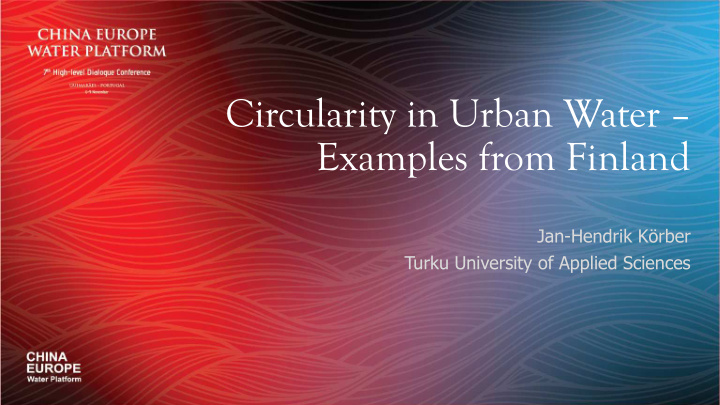



Circularity in Urban Water – Examples from Finland Jan-Hendrik Körber Turku University of Applied Sciences
Finnish Approach to Circular Economy • Finland aims to be a forerunner in circular economy (CE) through: support of innovative services, product recycling, digital solutions legislative reforms provision of public financing incentives for sustainable public procurement • Finland is the first country with a Road Map to Circular Economy • Supporting projects on carbon neutral economies, sustainable food systems, timber construction waste recycling, soil restauration… • Finland aims to be carbon neutral by 2035, many cities adapt a smart & clean approach with Helsinki as forerunner Sources : Ministry of Agriculture and Forestry, SITRA, Helsinki Metropolitan Smart & Clean Foundation
The Urban Context • Globally, 54% of the population lives in urban areas, accounting for 85% GDP 1 • Cities consume 75% of natural resources & generate up to 80% GHG emissions 2 • Urbanisation rate in Finland: 85% 3 • Concentration of people, material & waste flows & industries allow for effective circular business models Sources : 1 World Bank, 2 UNEP, 3 Statista
Water and Circular Economy • Closed-loop systems and rain water harvesting systems for individual housing still in their infancy • Circular systems in agriculture are advancing Full-scale circular urban water systems: • Municipal waste water treatment • Potable water production • Nearly closed-loop industrial cleaning systems • Recirculating systems for consumer-near aquaculture & vegetable production
Waste Water Treatment – Turku WWTP • One of the best waste water treatment plants (WWTP) in terms of resource efficiency • Highly automated • Operated by Turun Seudun Puhdistamo Ltd. • Serves 300,000 people region • Committed to work towards the UN SDGs • Constantly developing to improve efficiency, reduce stormwater inflow, provide industrial WW solutions Source : Turun Seudun Puhdistamo Ltd.
Waste Water Treatment – Turku WWTP Energy effiency: • Turku WWTP produces ~ 10x the energy it consumes • Provides ~10% of district heating & 95% of cooling • Generates ~18,000MWh from biogas production • Recovers 2,800MWh ventilation heat • Produces additional 20MWh from solar cells • Development: turbine at outlet Source : Turun Seudun Puhdistamo Ltd.
Waste Water Treatment – Turku WWTP Nutrient recycling: • Moving from removal to recovery • Advanced sludge recycling for fertiliser production • Liquid nitrogen production • Biogas generation (66GWh by 2020) Source : Turun Seudun Puhdistamo Ltd.
Potable Water Production • Ground water resources in SW are scarce • Ground water is artificially generated for the Turku area by the Turku Region Water Ltd. • The process used entirely natural treatment processed trough infiltration in a esker system • Though the processes are naturally they are Littoral sand fully controlled Silt-clay Gf. fine • Controll is facilitated by advanced models & Gf. coarse modelling Till Bedrock Source : Turku Region Water Ltd.
Potable Water Production • Ground water is led gravity-driven through pipes to undergound reservoirs blasted in the rock • Water is slowed down by turbines that generate energy required for pumping • The technology allows to use & re-use natural resources for production of potable water in a energy efficient way using combinations of natural processes & highly automated process control Source : Turku Region Water Ltd.
Closed-Loop Systems for Industrial Waters • A number of Finnish companies develop closed-loop systems for industrial water use • Examples include: re-usable cotton towel & work wear cleaning 1 car wash water treatment 2 , recycling rate 90% Sources : 1 Lindström Ltd., 2 Clewer Ltd.
Closed-Loop Systems in Aquaculture & Vegetable Production • Recirculating aquaculture & aquaponics are becoming more common • New technologies bring food production to the consumers • Systems by Sybimar Ltd. recycle nutrients, water, heat & CO 2 back to food & energy production • Water & nutrients are used in greenhouses • Bio-oils & gas are produced from waste (VG EcoFuel) • Heat from gas-based energy generation is used in greenhouses Source : Sybimar Ltd.
Emerging Technologies Among others, the following technologies are advancing rapidly: • Stormwater filtration technologies & methodologies for, e.g. nutrients & plastic recovery 1,2 • Low-energy nitrogen production from mobile toilets that maybe used, e.g. at large outdoor events 3 • Smart monitoring & metering technologies to identify leakages & reduce water loss/consumption 4 Sources : 1,2 Smart & Clean Foundation, Olli Hakala; 3 Sitra, 4 Lahti Aqua Ltd.
Conclusion • The Finnish government, industries, public & citizens are moving to a smart sustainable society • Circular economy will become the main model of operation in future • The aim to become carbon neutral within 15yrs is supported with development funds & legislative changes • Urban areas are a strong driver for changes • Water is essential part of circular systems
Recommend
More recommend